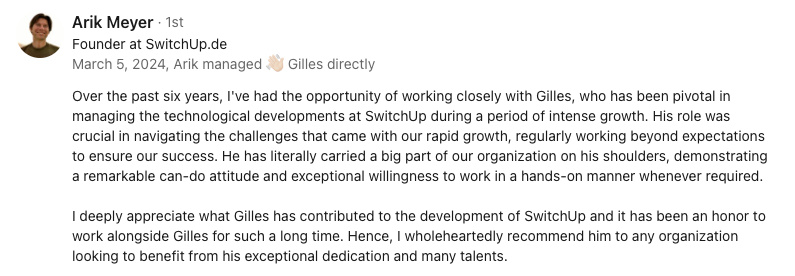Abstract:
In the realm of technology, the drive to create solutions that cater to every individual, including those with disabilities, is more crucial than ever. This article explores various technological advancements designed to improve the quality of life for individuals with disabilities. From cutting-edge software that enhances communication for people with speech impairments to innovative mobility devices that offer greater independence, these technologies embody the spirit of inclusion. The emphasis is not just on the functionality but also on how these solutions can be seamlessly integrated into everyday life, ensuring that technology is a tool for empowerment rather than a barrier. By highlighting examples of accessible technology, this discussion underscores the importance of collaboration between engineers, designers, and the disabled community to foster a more inclusive society where technology serves everyone.
Technology's Role in Accessibility and Inclusion
As Chief Technology Officer, I often reflect on the profound influence technology has on our lives, especially its capability to foster inclusion. Accessible technologies are not just tools; they are lifelines that provide a voice, mobility, and independence to those with disabilities. These innovations are demolishing barriers daily, creating a world where everyone has the opportunity to participate fully and independently.
Take, for example, the story of Jane Doe (name changed for privacy). Jane is visually impaired and has recently started using a screen reader that not only reads text aloud but also describes images and provides easy navigation through tactile responses on her devices. She shared with me, "This technology hasn’t just made things easier; it's given me freedom—the freedom to interact with the world on my terms." It's moments like these that underscore the transformative impact of these tools.
The strides we are making in technology for accessibility are indeed hopeful and full of potential. Innovations in communication aids like speech recognition software and real-time captioning services are breaking down previous communication boundaries. Similarly, advancements in mobility technology such as smart wheelchairs and navigational apps tailored for different disabilities are revolutionizing what mobility independence looks like.
Yet, while the technical aspects are impressive, it is the empowerment they provide that truly revolutionizes lives. As someone steering technology within my organization, I am continually inspired by our potential to make meaningful differences through innovation and collaborative development. Every line of code and device designed not only supports functionality but champions the cause of inclusion.
Smiling at the thought, I realize how enabling technology not only makes life easier, but also richer and more fulfilling for everyone involved. It's a privilege to be a part of such a community-focused endeavor, and I look forward to the continued breaking of boundaries, one innovation at a time.
Technological Innovations in Communication
As a figure deeply embedded in the technology sector, I've witnessed firsthand the staggering impact of innovation on communication, especially for individuals with disabilities. The transformation has been not just impressive but deeply empowering. Let's explore how we've been progressing in this field.
Voice Recognition and Real-Time Translation
Advancements in voice recognition software have been nothing short of revolutionary. These tools offer individuals with speech impairments the ability to communicate their thoughts and needs without traditional speech. My experience overseeing projects in this area has shown that the most effective software learns from user input, adapting to specific speech patterns and improving accuracy over time.
One poignant example is a communication app we've been involved in developing, aimed at translating text to speech—and vice versa. This app not only allows for seamless interaction with voice-controlled home devices but also provides practical support in real-world situations. Think about the relief and joy when a person who struggles with vocal communication orders their own coffee for the first time using only their smartphone.
Collaboration and User Feedback
One key element in these technological advances is the ongoing dialogue between developers and users. I've sat in many meetings where feedback from users prompted us to tweak features that we, sitting in our design labs, might not have considered significant. This collaborative approach not only perfects the functionality but makes the technology truly user-centric.
- User input: This is integral to refining the technology to meet actual needs rather than hypothetical ones.
- Iterative testing: Rigorous testing phases help in understanding various use case scenarios and ensuring the technology is robust and reliable.
The Impact of Advanced Communication Tools
The influence of these innovations extends beyond mere convenience; they foster independence and self-expression. I remember meeting a young man, let’s call him Tyler, who has cerebral palsy. Tyler used a specially designed communication tablet that allowed him to speak through text-to-speech technology. The first time I heard him 'speak' through the device, he said, "This is my voice now, and it’s powerful." Tyler’s story beautifully expresses how these technologies give a voice to those who might otherwise be unheard.
The self-sufficiency these tools promote isn’t just about massively improving quality of life; they're a leap towards inclusivity in a world that speaks in myriad ways. Standing on the forefront of these developments, I feel both challenged and cheered. Each code we write, each user test we conduct, and each piece of feedback we integrate brings us closer to a society where everyone has a voice. That keeps not just me, but my entire team, energized to push the boundaries of what's possible.
Reflecting on our journey so far, it’s thrilling to think about where we are heading. Smiling to myself, I often think how technology, in many ways, is like coffee – both are better when they adapt to the individual’s taste. Just as no two coffee lovers like their brew the same way, each user of communication technology benefits from a personalized approach. And as someone deeply invested in these innovations, I get a front-row seat to witnessing these transformations, each day adding a new chapter to this enriching story.
Advancements in Mobility and Physical Accessibility
Stepping into the realm of mobility and physical accessibility, I've been both a witness and participant in remarkable advancements, markedly enhancing the lives of individuals with mobility challenges. From high-tech wheelchairs to agile prosthetics, the fusion of AI and robotics is creating marvels that not only restore mobility but also amplify human capabilities beyond traditional limits.
Robotic Prosthetics: A Leap Forward
The development of robotic prosthetics exemplifies how technology can drastically alter human experience. These aren't your run-of-the-mill faux limbs; they're marvels equipped with AI that analyzes user gestures and surrounding environments to provide seamless, intuitive control. Seeing someone manipulate their environment with such a device for the first time can resemble a scene from science fiction—yet, it's our reality. As a tech leader, it's exhilarating to facilitate projects that achieve such profound human impact.
I recall a conversation with a young musician, Sarah, who lost her arm in an accident. Post-accident, Sarah struggled with different prosthetic arms, none of which allowed her the dexterity required for playing her violin. We introduced her to a new AI-driven prosthetic, designed to respond to minute muscular movements. The first time Sarah played a violin piece using her new arm, the joy was palpable. It was more than just a return to music; it was a reclamation of her passion, enabled by technology.
Revolutionizing Wheelchair Technology
Modern wheelchairs are no longer just about mobility; they are about empowerment. These advanced machines come integrated with technologies that can climb stairs, navigate over rough terrain, and even elevate a seated person to eye level with standing peers, transforming interactions and enhancing social engagement.
- Stair-climbing wheels: One innovative feature drastically changes how users interact with spaces typically hindered by stairs.
- Terrain adaptation: Advanced sensory and motor capabilities allow these wheelchairs to traverse various surfaces, making outdoor adventures more accessible.
The world of wheelchairs was fascinating enough, but throw in the capabilities of AI, and you're essentially looking at a personal vehicle that not only transports but interacts with its user. I had the opportunity to observe a trial where a new model was introduced to a group of users. The wheelchair's ability to automatically adjust its seating for comfort and stability depending on the terrain was a game-changer. Watching the faces of the testers light up as they moved freely across a previously impassable grassy field was one of those moments that stick with you—it wasn't just the technology advancing; it was life itself progressing.
Exoskeletons: The Pinnacle of Assistive Technology
Last but certainly not least, exoskeletons represent the pinnacle of merging human intent with robotic assistance. These frameworks, worn over the body, provide support, augment strength, and aid movement. They're particularly transformative for individuals with spinal cord injuries or severe mobility limitations.
A case that beautifully illustrates this is John, a former athlete who experienced a severe spinal injury. Post-injury, John’s ability to walk was severely compromised. The introduction of an exoskeleton into his rehabilitation regime wasn’t just about physical therapy; for John, it was about regaining a part of his identity. The technology didn’t just support his weight; it supported his aspirations. It was a profound reminder of why the work we do in tech isn’t just about crafting sophisticated gadgets; it’s about crafting opportunities for personal triumph.
Reflecting on these advancements, the blend of humor might seem a bit out of reach when discussing such heavy topics, but you know what they say—laughter can be the best grease for the wheels, even if those wheels are part of a high-tech wheelchair. Witnessing these technological leaps in person has not only been a highlight of my career but a continuous source of inspiration.
The Importance of Community and Collaborative Efforts
In the world of tech and accessibility, it's a collective endeavor. The synergy between engineers, designers, and the disability community plays a crucial role in shaping solutions that truly resonate with the needs of users. After all, a tool can only be as good as the input that molds it, and who better to provide this input than the people who will utilize these innovations daily?
Collaborative Design: More Than Just Building Together
Having led numerous tech projects aimed at enhancing accessibility, I have seen how powerful collaborative design can be. It's not just about bringing together diverse minds but engaging with the actual users whose lives we aim to improve. This feedback loop does more than just fine-tune features; it gives a voice to the experiences and challenges that might otherwise be overlooked. Like a symphony where every note matters, each feedback session with disabled users guides our engineers and designers toward more empathetic and effective solutions.
This collaboration often takes numerous forms, from prototype testing sessions to ongoing discussions via digital platforms, where users can pitch their insights and frustrations directly to those developing the technology. It's as if every session is a brick laid in the foundation of a more accessible future, ensuring we build not just for but with our community.
User-Centered Innovation: The Core of Technological Advancements
In my role, I have observed that the magic happens in the intersection between high tech and high touch—where cutting-edge technologies meet detailed, human-centered feedback. For instance, when we developed a new version of a text-to-speech app, the inclusion of actual user voices in the development process led to a more intuitive interface that better suited users with varied disabilities. The result? A product that not only spoke but resonated deeply with its users.
- Empathy-driven engineering: Engineers and designers are tasked not only with solving problems but with understanding the lived experiences of people with disabilities.
- Ongoing education: Regular interaction with end-users educates technical teams on the realities of living with disabilities, which in turn shapes more nuanced and useful technologies.
The road to truly transformative technology is paved with these ongoing dialogues, fostering a depth of understanding that pushes our technical boundaries even further.
Empowering a Network of Participation
The concept of inclusive technology is as much about the tools we create as it is about the community we foster around those tools. By engaging in open dialogues and collaborative efforts, we not only innovate but also empower individuals to become advocates and collaborators in their own right. It's heartening to see users turn into champions, guiding our projects with their invaluable perspectives.
So, whether you're a seasoned developer, a curious onlooker, or a potential user, I welcome you to join us in this journey. Your insights and support can ignite further innovations, helping to realize a society where technology is not a barrier but a bridge. Together, we can shape a world that reflects all of its members, with every program we code and every product we launch paving the way for inclusivity and independence.
Reflecting on these engagements always brings a smile to my face. There's something almost poetic about the union of human concerns with technological solutions—where every algorithm isn’t just a sequence of steps but a step towards greater inclusivity.
As I continue navigating the path of innovation in accessibility, I am reminded daily of the vibrancy and potential of this collective approach. It's a reminder that when we come together, the future is not just a concept to be engineered but a promise to be fulfilled. Let's keep the dialogue flourishing and the innovations coming.
Every line of code matters, every feedback counts, and each one of you can contribute to this beautiful narrative. So, let's keep building—together.
You might be interested by these articles:
- Enabling Tech for the Disabled
- Innovative Assistive Tech Solutions
- Harnessing Europe's Diversity for Accessibility Innovation
See also:
- Gilles Crofils: Skills, Industries and Markets
- Navigating the Shift to Decentralized Work
- Advancing Security with Cryptography
- Next-Gen AgriRobots Transforming Farming
- Embracing Flexibility: The Future of Workspaces and Leadership
- Revolutionizing Work with Remote Technologies
- Robotic Process Automation Implementation





